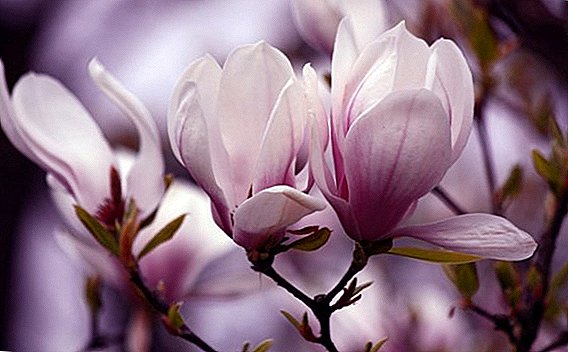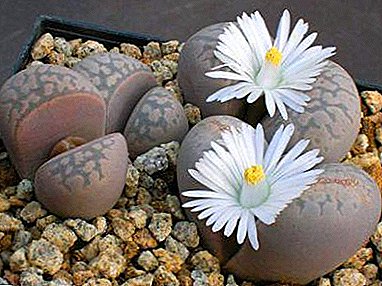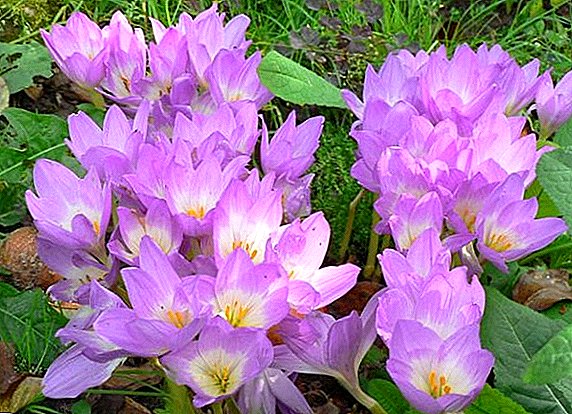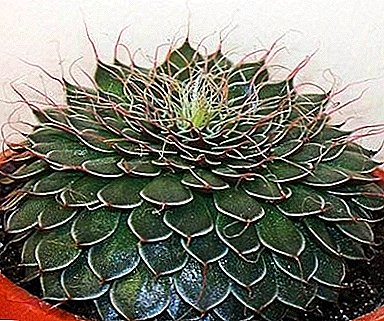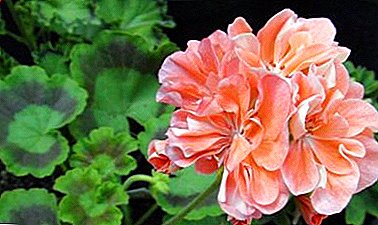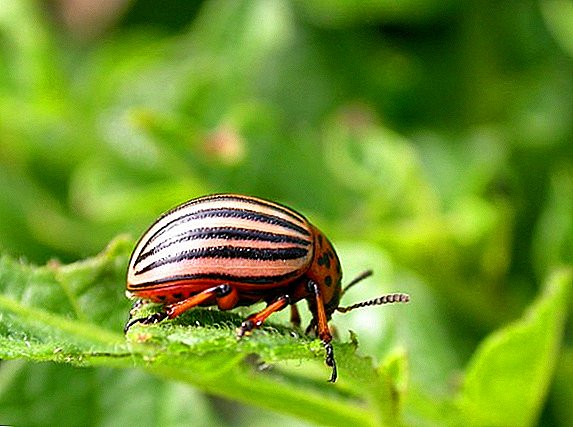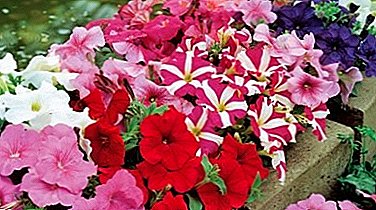
Petunias are quite popular flowers and are on the leading positions among annual plants. This is due to the bright flowering and fairly straightforward care. They can be planted in a flower bed, and on the balcony or porch of the house.
Petunia bloom is most often represented by a bright waterfall of inflorescences that allow you to enjoy your view from the very first warm days until the end of the autumn season.
What it is?
More than 200 years ago, in the tropics of Brazil and South America, the first types of petunias were discovered. Since the word "petunia" is translated as "tobacco", it was assigned to the genus Tabakov. Today, petunia belongs to the genus of shrub, herbaceous plants, and is represented by a variety of more than 40 species of flowers.
She can please the eye both one season and a long time. The appearance of petunia, most often represented by braiding inflorescences.. However, sometimes it occurs in the form of shrubs with straight or creeping stems. On the stems there are many ovaries, which eventually turns into beautiful flowers that have an attractive appearance, but most often a repulsive smell.
Variety varieties and their features
To date, there are a huge variety of species and varieties of petunias, which differ in the shape, color and appearance of flowers. Conditionally, petunia is divided into:
- large-flowered;
- many-flowered
The first is characterized by a rare structure with large flowers, and the second is by small flowers of bright colors. Also, these species differ in their place of growth. Since the large-flowered petunia is rather fastidious under certain meteorological conditions, it is mainly planted for decoration in pots. Multi-flowered flowers are less vulnerable and pleases the eye in flowerbeds without any problems.
The following varieties of petunia hybrid are distinguished.
Picotee
It is considered an annual plant and blooms in the warm season.. The inflorescence is presented in the form of a funnel with a rim of white or red.

Mirage Velvet
Climbing, a lot of seasonal plant. The flower is presented in red, in the form of a funnel with a wide bend.

Primetime
Most often grown as an annual plant with bright inflorescences, presented in different colors. The petals are pronounced dark streaks. Can reach up to a meter in height.

Aladdin
Twine flower in the shape of a bush. Flowers can be painted in a variety of colors, and the leaves are mostly oval.

Terry
Also, there are mixes and mixes of petunias. A bright representative of the mix is terry petunia. Her name speaks for itself. During the flowering period, the edges of the petals become velvety, and the inflorescences themselves become laced. However, the big disadvantage is the vulnerability of terry petunia in bad weather.

You can learn more about petunia terry from this useful video:
Where and how to plant a hybrid?
For the successful growth of petunias hybrid, it is important to know the rules of its landing. There is the possibility of planting with the use of seeds or seedlings.
The best time for planting seeds is the second decade of March. It is necessary to prepare the soil, which includes peat with sand. Before planting, it is necessary to moisten the soil well and sift its top layer for even placement of seeds.
There are such types of seeds as:
- Small. When disembarking, they are mixed with sand and spread over the surface of the soil, then a little sprinkled on them. Next, you need to pour and cover with foil.
- Granular land using tweezers. To simplify the dive and better development of the plant, it is necessary to plant this type of seed in an even row.
In order to avoid the appearance of plant diseases, it is important to monitor the condensate on the film and clean it in a timely manner. For prevention, it is recommended to replace water when spraying with a solution of potassium permanganate. When the first leaflet germinates, it is necessary to remove the film, reduce the intensity of watering and sprinkle the soil with sand.
It is convenient to plant seeds in transparent containers with a lid.. With regards to seedlings, it should be planted in the presence of 4 leaves on the plant in the ground with the same composition. It is recommended to deepen, for the formation of further strong roots.
During this period, it is important to maintain the wet state of the soil, to loosen it, to fertilize it. Also there is a plant acclimatization. It is carried out by placing seedlings of petunia for a short time in a room with a lower temperature.
Transplantation of petunia occurs in warm time in loose soil. Petunia fertilizer in this period is not necessary. After some time, you need to hold the plant pinching.
Soil requirements
 Places of petunia growth can be both a pot and open ground. With regards to the soil, petunia is not demanding, however, a large amount of nitrogen in its composition will positively affect the growth of the plant. Due to the tendency to fungal diseases, it is not recommended to fertilize petunia with humus.
Places of petunia growth can be both a pot and open ground. With regards to the soil, petunia is not demanding, however, a large amount of nitrogen in its composition will positively affect the growth of the plant. Due to the tendency to fungal diseases, it is not recommended to fertilize petunia with humus.
After the end of the cold season you can embark. The root system of plants is sufficiently developed, so the adaptation will take place without problems.
Lighting and location
The best place for growth of petunias is considered to be calm and sunny terrain, since it is thermophilic and vulnerable to changing weather conditions. Regarding the landing site, it can be represented both in the form of a flower bed, and open ground. Do not lose sight of such places of growth of petunias as a hanging pot and pot. They quite often decorate balconies or facades of houses.
How to care?
Caring for petunias includes the constant removal of faded inflorescences for the early formation of new ones. The soil must be kept wet and loose. However, the stagnation of moisture is unacceptable. Watering is recommended in the evening. Feed should be no more than three times a month with strict adherence to proportions. Otherwise, the plant is threatened with death.
It is necessary to monitor the appearance of the plant to find the right fertilizer:
- when buying leaflets purple color need phosphate fertilizer;
- when yellowish spots appear - fertilizer, which is composed of iron;
- in the process of bud formation need phosphorus-potassium fertilizer.
Common diseases and pests
Sometimes, improper care can cause various plant diseases. Petunias are more susceptible to infection.:
- Gray rot. With this type of disease, the leaves are covered with brown spots, then dry and covered with fluff. It is possible to become infected by penetration of the fungus into the soil.
- Powdery mildew down up. An outward sign of this disease is a white bloom on the leaves.
- Black leg. The stem gradually darkens and rots, and the leaves turn yellow.
Important! If ever the plant has been subjected to any kind of disease, petunia should not be planted at the place of its growth.
To combat these diseases are used as folk remedies, and pharmaceutical preparations. However, apart from diseases some species of insects are dangerous to petunias:

- Aphidcovering all parts of the plant. After some time, the affected areas, with the fungus that has formed on them, twist into a tube.
- Spider mitewhich prefers in the form of localization of the inner surface of the foliage, forming a web along the entire stem. The outer side of the plant is covered with white spots, and after a while, the leaves dry out and fall off.
- Thrips. These small dark-colored beetles are localized in groups solely on the leaves. After them, dried leaves appear on the foliage, and the flowers fall.
Breeding features
Propagation of petunia is possible through the use of seeds, seedlings, cuttings:
- The most elementary way is considered the use of seedlings.. However, a significant disadvantage can be a high price.
- Cutting is in demand among experienced flower growers. It allows you to get a beautiful bush with frequent flowering. The most appropriate period is considered the beginning of spring.
- Before separating the stalk from the main plant, it is necessary to make sure that there are no various diseases.
- Next, you should ensure the growth of roots, by placing petunia in the water or in the sand.
- To stimulate growth, it is necessary to pinch the leaves.
- The least popular method of breeding petunias is considered the seed method.. It is always accompanied by certain problems and difficulties. Seeds need to be planted in the soil one by one, and this is sometimes impossible, because of their very small size. Also, the planting of seeds is preceded by the preparation of the soil, which includes many nuances.
Possible problems
When growing petunias, there is a chance to encounter certain problems.:

- With plant deathor if the seedlings have not grown at all, the main reason is considered to be the planting of poor quality seeds.
- Also found lowering seedlings on one side. This occurs in low light, watering at low temperature or removing the film ahead of time. For the correct and beautiful formation of a bush of petunia, it is necessary to pinch or pinch. This process is a tuck of the main kidney, to increase lateral growth. Pinching is an important technique.
- Gardeners face the challenge yellowing first foliage in petunia. This problem occurs when the temperature drops, iron deficiency, or with the defeat of a spider mite.
Hybrid petunia is represented by a large variety of varieties that have a beautiful and attractive appearance. The peak of petunia bloom occurs in the first summer months. However, to maintain the beauty of this plant requires careful and regular care for him. If the petunia is provided with everything necessary, it will be pleasing to the eye for a long time.


